We included HMH Into Math Grade 8 Answer Key PDF Module 1 Lesson 5 Understand and Recognize Congruent Figures to make students experts in learning maths.
HMH Into Math Grade 8 Module 1 Lesson 5 Answer Key Understand and Recognize Congruent Figures
I Can determine congruence by performing or describing a sequence of transformations that maps one figure onto another.
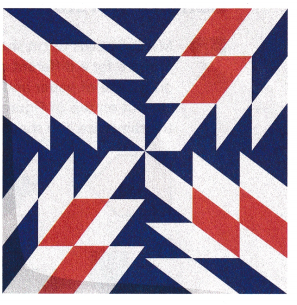
Spark Your Learning
Maribel wants to make a quilt like this one. She has quilt pieces that are triangles and quilt pieces that are parallelograms. Describe ways she can transform the shapes to match the pattern in the quilt.
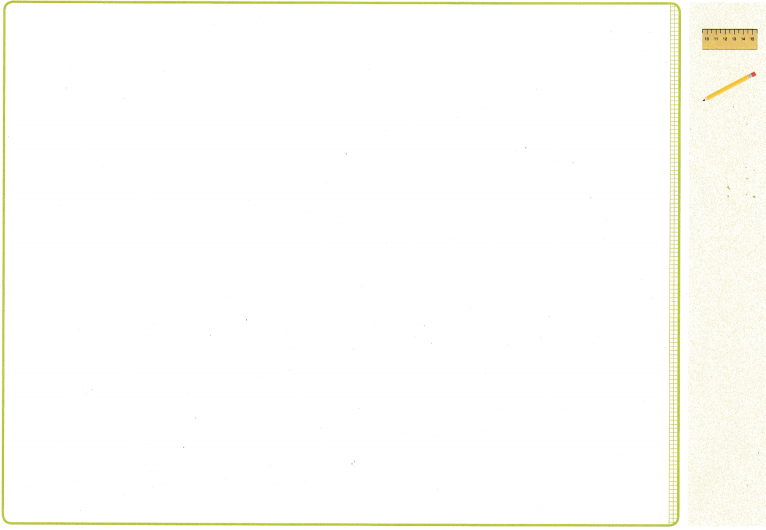
Answer:
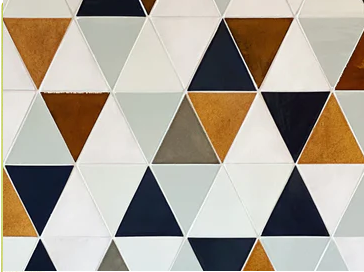
Explanation:
Congruence is seen in the above quilt by performing or describing a sequence of transformations that maps one figure onto another.
Marbiel can transform the triangles and parallelograms in the quilt by sliding or rotation.
Turn and Talk Design a second quilt using parallelograms and triangles. Exchange your design with a partner and have him or her describe the transformations you used to design your quilt.
Answer:

Explanation:
Transformation of Rotation and Translation is done.
Rotation means the circular movement of an object around a center.
It is possible to rotate different shapes by an angle around the center point.
A translation is a type of transformation that takes each point in a figure,
and slides it the same distance in the same direction.
Build Understanding
Maribel needs to cut shapes out of fabric to prepare for a different quilt. Trace Figure 1 on a piece of paper and cut it out. Lay your cut-out on top of Figure 1 to make sure it is the same size and shape.
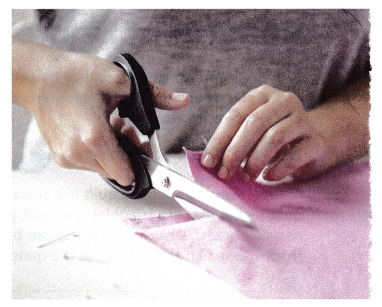
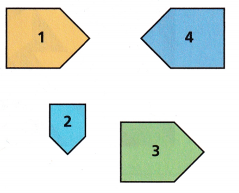
A. Experiment with transformations to move the cut-out shape on top of Figure 2. What transformations did you use? Explain how the figures are the same and how they are different.
Answer:
Figure 1 and Figure 2 are same in shape with a dilation factor d = \(\frac{1}{k}\)
Explanation:
if k = 2
dilation factor d = \(\frac{1}{2}\)
then rotation is shown below,

B. Experiment with transformations to move the cut-out shape over Figures 3 and 4. What transformations did you use?
Answer:
Figure 1 transformations to move the cut-out shape over Figures 3 and 4
as shown below figure 3 and 4
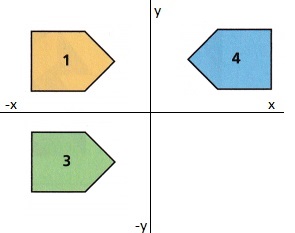
Explanation:
Figure 1 to Figure 4 is by reflection with reference to y-axis.
figure 1 to Figure 3 is by reflection with reference to x-axis.
C. What do you notice when you compare Figure 1 to Figures 3 and 4?
Answer:
with reference to the Figure 1, 3 and 4,
all are with same side and shape and are congruent figures.
D. A figure is congruent to another figure if and only if a series of rotations, reflections, and translations can map one onto the other. Which figures are congruent?
Answer:
with reference to the Figure 1, 3 and 4,
all are same side and shape and are congruent figures.

Connect to Vocabulary
Congruent figures are the same size and shape.
Turn and Talk Is there a series of rotations, reflections, or translations you can perform on Figure 2 to produce Figure 1, 3, or 4? Explain.
Step It Out
2. While preparing fabric for quilting, Maribel lays a grid over her fabric. She wants to cut out five congruent triangles. She draws the triangles on the coordinate grid below.
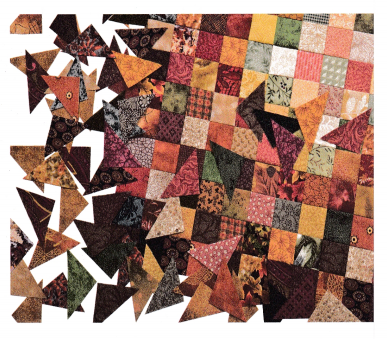
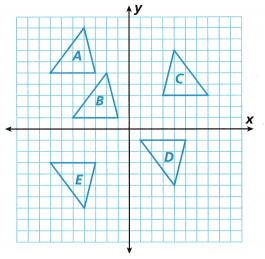
A. Triangle A is translated 2 units down and then reflected across the y-axis. Which triangle is the image of this sequence of transformations?
Answer:
Triangle C
Explanation:
As shown in the below figure ,
Triangle A is shifted 2 units down and reflected with respect to y axis.
Triangle C is reflected image of Triangle A.
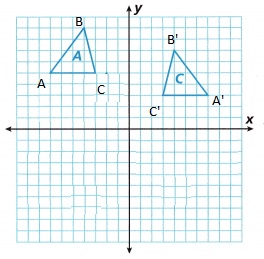
B. Are the two triangles congruent? Explain how you know.
Answer:
Yes,
Explanation:
Both the triangles A and C are congruent in shape and size.
Triangle C is reflected image of Triangle A.
C. Which two transformations can you perform on Triangle B to show that it is congruent to Triangle D?
Answer:
Translation and Rotation.
Explanation:
First transformation 6 units left shifting as below,
F(x, y) → F’ (x+6, y) transformation to be done
Then second rotating a point 90 degrees counterclockwise about the origin point,
A(x, y) becomes A'(-y, x).

First transformation 6 units left shifting as below
F(x, y) → F’ (x+6, y) transformation to be done
Then second one to rotate the figure 90 degrees clockwise about a point,
every point(x, y) will rotate to (y, -x).
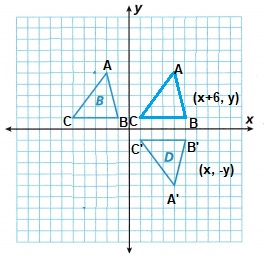
Let’s understand the rotating a point 90 degrees counterclockwise about the origin point,
A(x, y) becomes A'(-y, x).
D. Record the vertices of Triangle A and Triangle B. Use mapping notation to show how the vertices of Triangle A changed, and read the mapping notation aloud to another student. Explain how you know the shapes are congruent.
Triangle A → Triangle B
![]()
Answer:
![]()
Explanation:
Mapping Notation is used to figure out the points of parabola to plot onto the graph.
When two figures or objects have the same shape and size,
or if one has the same shape and size as the mirror image of the other,
then it is said that the shapes are congruent.
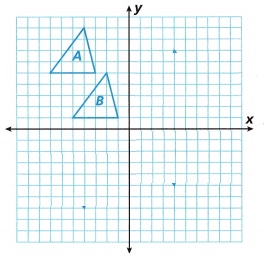
3. Maribel wants to cut a new shape. She will reflect Figure A across the x-axis and translate the image 5 units left. She claims that the order in which she performs the transformations matters. Is she correct?
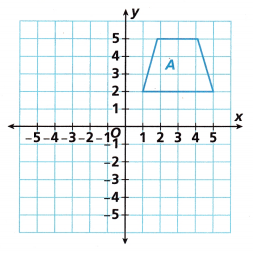
A. Reflect Figure A across the x-axis and then translate the figure 5 units left. Draw the final image.
Reverse the order of the transformations and draw the image again. How did the order you performed the transformations change the final image?
Answer:
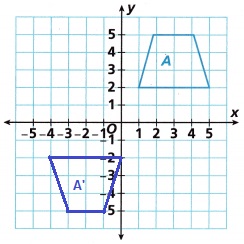
Explanation:
First 90 degrees clock wise transformation to be done as,
rotate a point 90 degrees counterclockwise about the origin our point A(x, y) to A'(-y, x).
Figure A across the x-axis and then translate the figure 5 units left,
A(x ,y) A'(x-5 , y)
B. The vertices of Figure B have coordinates shown in the table. Figure B is rotated 90° clockwise about the origin and then reflected across the x-axis to form Figure C. Figure B is also reflected across the x-axis and then rotated 90° clockwise about the origin to form Figure D. Complete the table.

Answer:

Explanation:
vertices of Figure B have coordinates,
(0, 0), (0, -3), (2, -3), (1, -1), (2, 0)
Figure B is rotated 90° clockwise about the origin.
Rotate the figure 90 degrees clockwise about a point, every point(x, y) will rotate to (-x, y).
(x, y) will rotate to (y, -x)
(0, 0), (-3, 0), (-3, -2), (-1, -1), (0, -2)
reflected across the x-axis to form Figure C
When you reflect a point across the x-axis, the x-coordinate remains the same,
but the y-coordinate is taken to be the additive inverse.
The reflection of point (x, y) across the x-axis is (x, -y).
vertices of Figure C have coordinates now
(0, 0), (-3, 0), (-3, 2), (-1, 1), (0, 2)
vertices of Figure B have coordinates
(0, 0), (0, -3), (2, -3), (1, -1), (2, 0)
The reflection of point (x, y) across the x-axis is (x, -y).
(0, 0), (0, 3), (2, 3), (1, 1), (2, 0)
To rotate the figure 90 degrees clockwise about a point,
every point(x, y) will rotate to (y, -x).
(0, 0), (3, 0), (3, -2), (-1, -1), (0, -2)
C. How did the order you performed the transformations on the figure change the final images, Figures C and D?
Answer:

Explanation:
i) vertices of Figure B have coordinates is first rotated 90 clockwise then reflect with respect to x axis to form figure C.
ii) vertices of Figure B have coordinates is first reflect with respect to x axis then rotated 90 clockwise to form figure D.
Check Understanding
Use the figures to answer Problems 1-2.
Question 1.
Which of these figures are not congruent to Figure 1? Why?
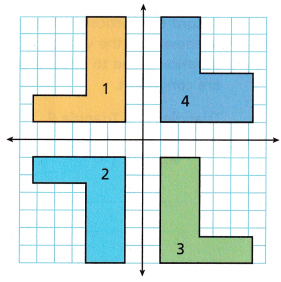
Answer:
Figure 4
Explanation:
Figure 1, 2 and 3 are same size and shape with same area
Figure 4 size and shape is not matching with Figure 1,2 and 3
Hence,
Figure 4 is not congruent to Figure 1
Question 2.
A. What sequence of transformations can you perform on Figure 1 to produce Figure 3?
Answer:
Reflection over y axis,
Shifting down to 8 units.
Explanation:
A reflection is known as a flip which is a mirror image of the shape.
An image will reflect through a line, known as the line of reflection.
A figure is said to reflect the other figure,
then every point in a figure is equidistant from each corresponding point in another figure,
as shown below…
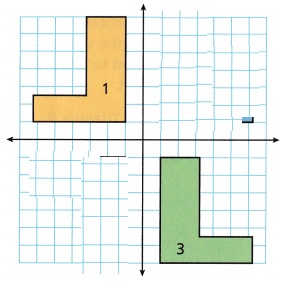
B. Write a mapping notation to show the result of this sequence of transformations.
Answer:
First transformation is reflection over y – axis,
Fig1 (x, y) is Fig 1′(-x, y)
Second transformation is shifting down 9 units,
Fig1 (x, y) is Fig 3(x , y-9)
Explanation:
Mapping Notation is used to figure out the points of parabola to plot onto the graph.
As shown in the below figure is mapping notation to show the sequence of transformations.
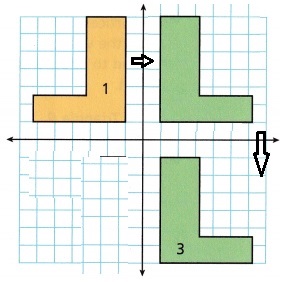
On Your Own
Question 3.
Can a square ever be congruent to a pentagon? Explain.
Answer:
No,
Explanation:
Two figures or objects are congruent if they have the same shape and size,
or if one has the same shape and size as the mirror image of the other.
So, a square ever be congruent to a pentagon because,
The sum of the interior angles of square is 360 degrees.
The sum of the interior angles of pentagon is 540 degrees.
Where as the square has 4 sides and pentagon has 5 sides.
Use the graph to answer Problems 4-10.
Question 4.
Open Ended What sequence of transformations can you perform on Figure C to produce Figure A?
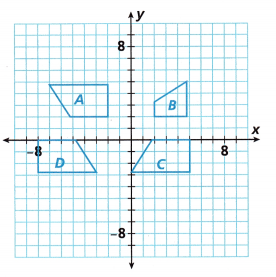
Answer:
Sequence of reflection over x-axis and shifting up 2 units.
Explanation:
First transformation is reflection over x-axis
Fig C(x, y) is Fig C'(x, -y)
Second transformation is shifting up 2 units
C'(x, y) A(x-7, y+2)
As shown in the below figure is mapping notation to show the sequence of transformations.
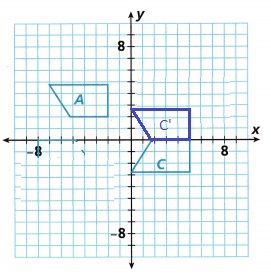
Question 5.
Figure D is translated 3 units right and reflected across the y-axis. Which figure will this sequence of transformations produce?
Answer:
Figure C
Explanation:
When Figure D is translated 3 units right and reflected across the y-axis,
we get the resultant transformation of figure as C.
Question 6.
Which figures are congruent to Figure A? How do you know?
Answer:
Figure C and D are congruent to Figure A.
Explanation:
The two figures or objects are congruent if they have the same shape and size,
or if one has the same shape and size as the mirror image of the other.
Question 7.
Figure B is translated 3 units up and then reflected across the y-axis to form Figure E. Draw Figure E on the coordinate grid.
Answer:
B(x, y) B'(-x, y + 3)
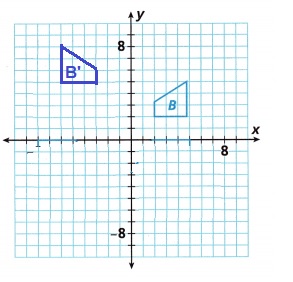
Explanation:
To rotate the figure 90 degrees clockwise about a point, every point(x, y) will rotate to (y, -x).
So, each point has to be rotated and new coordinates have to be found.
Question 8.
Critique Reasoning Nathan claims Figure B is congruent to Figure A. Is he correct? Explain.
Answer:
NO,
Explanation:
The two figures or objects are congruent if they have the same shape and size,
or if one has the same shape and size as the mirror image of the other.
as shown in the below figure , size and shape is not matching,
hence A and B are not congruent.

Question 9.
Without performing a transformation on Figure A, how can you use tools to be sure it is congruent to Figure D?
Answer:
By using a ruler and protractor.
Explanation:
due to the congruent shape and size and shape of figures are same, some tools can be used.
Ruler is used to measure and compare the side lengths.
Protractor is used to measure and compare the angles.
Question 10.
Without performing a transformation on Figure A, how can you use tools to be sure that it is not congruent to Figure B?
Answer:
By using a ruler and protractor.
Explanation:
the congruent shape and size and shape of figures are same, some tools can be used.
Ruler is used to measure and compare the side lengths.
Protractor is used to measure and compare the angles.
as lengths and angles are miss matching in the figure A and B, we can conclude as Figure A, how can you use tools to be sure that it is not congruent to Figure B.
Use the figures to answer Problems 11-13.
Question 11.
Which figures are congruent to Figure 1? Which are not congruent to Figure 1?
Answer:
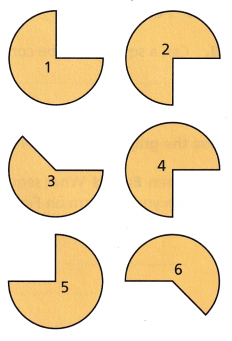
Answer:
Rotation by 180° about the origin: A rotation by 180° about the origin is shown.
The rule for a rotation by 180° about the origin is (x,y)→(−x,−y) .
Figure 2, 4 and 5 are congruent to figure 1.
Figure 3 and 6 are not congruent to figure 1.
Explanation:
Two figures or objects are said to be congruent if they have the same shape and size,
or if one has the same shape and size as the mirror image of the other.
Question 12.
What sequence of transformations can be performed on Figure 4 to produce Figure 1?
Answer:
Transformation of Rotation.
Explanation:
A rotation is a transformation that turns a figure about a point.
Rotation means the circular movement of an object around a center.
It is possible to rotate different shapes by an angle around the center point.
Question 13.
Kailee reflected Figure 5 across a vertical line and then translated it up. Which figure is the result?
Answer:
Figure 1
Explanation:
A reflection is a transformation that flips a figure across a line,
which is a mirror image of the shape.
When figure 5 is reflected across a vertical line and then translated up,
the resultant figure is 1.
Use the graph to answer Problems 14-17.
Question 14.
Critique Reasoning Henrietta claims that Figure B can be transformed into Figure A by translating it 2 units right and rotating it 90° clockwise about the origin. Is she correct? If not, find and correct her error.

Answer:
No, Henrietta is not correct.
Explanation:
Figure B can be transformed into Figure A by translating it 2 units right and rotating it 90° clockwise about the origin is shown in the red color rectangular figures B’ and A’.
To rotate the figure 90 degrees clockwise about a point, every point(x, y) will rotate to (y, -x). Let’s understand the rotation of 90 degrees clockwise about a point visually.
So, each point has to be rotated and new coordinates have to be found
Question 15.
Figure C is rotated 90° clockwise about the origin and translated 4 units down. Which figure will this sequence of transformations produce?
Answer:

Explanation:
Rotation means the circular movement of an object around a center.
It is possible to rotate different shapes by an angle around the center point.
When Figure C is rotated 90° clockwise about the origin and translated 4 units down,
the sequence of transformation that produce is figure B.
Question 16.
How can you prove that Figure A is congruent to Figure C?
Answer:
Transformation of Rotation.
Explanation:
A rotation is a transformation that turns a figure about a point.
Rotation means the circular movement of an object around a center.
It is possible to rotate different shapes by an angle around the center point.
Two figures or objects are said to be congruent if they have the same shape and size,
or if one has the same shape and size as the mirror image of the other.
Question 17.
Figure B is translated 5 units left and then reflected across the x-axis to form Figure E. Draw Figure E on the coordinate grid.
Answer:

Explanation:
Figure B is shifted to 5 units left to form Figure B’
figure B(x, y) is figure B'(x-5, y),
reflection over x axis is shown in the above figure.
I’m in a Learning Mindset!
How does my mindset affect my confidence with performing reflections?
Answer:
A reflection is a transformation that acts like a mirror.
Explanation:
It swaps all pairs of points that are on exactly opposite sides of the line of reflection.
The line of reflection can be defined by an equation or by two points it passes through.
Self-reflection is the key to self-awareness and it allows us to look neutrally at our thoughts, feelings, emotions, and actions.
Lesson 1.5 More Practice/Homework
Use the kites shown to answer Problems 1-3.
Question 1.
Draw a figure that is congruent to Figure 3. How can you prove that your figure is congruent using tracing paper?
Answer:
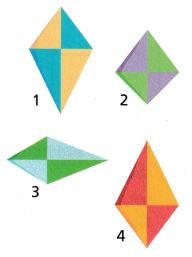
Answer:

Explanation:
Trace figure 3 and place it over the original figure to show that they match exactly in size and shape or congruent to each other.
Question 2.
Mirai transforms Figure 1 into Figure 4. What sequence of transformations did Mirai perform?
Answer:
Transformation of Rotation.
Explanation:
A rotation is a transformation that turns a figure about a point.
Rotation means the circular movement of an object around a center.
It is possible to rotate different shapes by an angle around the center point.
Question 3.
Reason Can you perform a series of transformations on Figure 1 to form Figure 2? Explain.
Answer:
No,
Explanation:
The figure of 1 is different from figure 2,
in its size and shape.
So, we cannot perform a series of transformations on Figure 1 to form Figure 2.
Use the graph to answer Problems 4-7.
Question 4.
A. Figure B is reflected across the x-axis and translated 2 units left to form Figure E. Draw Figure E.

Answer:

Explanation:
When we reflect a point over the x-axis, the x-coordinate remains the same,
but the y-coordinate is taken to be the additive inverse.
The reflection of point (x, y) across the x-axis is (x, -y).
Translated 2 units left to form Figure E.
(x, y) is translate to (x, y – 2).
B. Ricardo translates Figure B 2 units left and then reflects it across the x-axis. What is the same about Ricardo’s drawing and your Figure E, and what is different?
Answer:
No difference, both are same.
Explanation:

Here first translate to 2 units left to form Figure B’
(x, y) is translate to (x, y – 2)
When we reflect a point over the x-axis, the x-coordinate remains the same,
but the y-coordinate is taken to be the additive inverse.
The reflection of point (x, y) across the x-axis is (x, -y).
Question 5.
What transformation can be performed on Figure A to produce Figure C? ______________________
Answer:
A Translation of 3 units down.
Explanation:
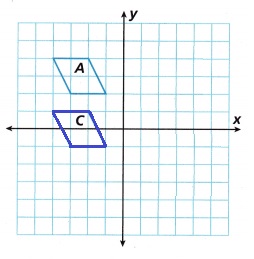
A translation is a type of transformation that takes each point in a figure,
and slides it the same distance in the same direction.
Question 6.
Open Ended What sequence of transformations can be performed on Figure B to produce Figure C?
Answer:
Translation of 2 units left and then reflects it across the x-axis.
Explanation:
A translation is a type of transformation that takes each point in a figure,
and slides it the same distance in the same direction.
Figure B moves 2 units left and then reflects it across the x-axis to produce Figure C.
Question 7.
Is Figure A congruent to Figure D? Explain.
Answer:
Yes,
Explanation:
Transformation of Rotation is seen in Figure A and Figure D.
A rotation is a transformation that turns a figure about a point.
So, both the figures are congruent to each other.
As congruent figures have the same shape and size,
or if one has the same shape and size as the mirror image of the other.
Test Prep
Question 8.
Select all figures that are congruent.

Answer:
Option A, B and E figures that are congruent.
Explanation:
The following tick marked are figures that are congruent.
As congruent figures have the same shape and size,

Question 9.
Figure A and its transformation Figure B are shown.

What transformations can be performed on Figure A to produce Figure S?
A. reflection across a vertical line followed by a translation to the right
B. reflection across a vertical line followed by a translation to the left
C. translation to the right followed by a reflection across a horizontal line
D. translation down followed by a reflection across a horizontal line
Answer:
Option C
Explanation:
A translation is a transformation that slides a figure.
A translation is a type of transformation that takes each point in a figure,
and slides it the same distance in the same direction.
In the above given figures translation is done to the right,
followed by a reflection across a horizontal line.
Question 10.
Triangle ABC is translated 2 units right and then reflected across the y-axis. Draw the image.
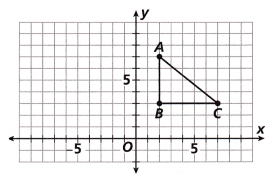
Answer:
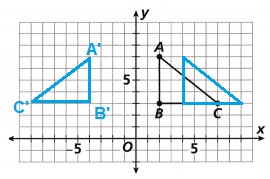
Explanation:
Triangle ABC is translated 2 units right and then reflected across the y-axis,
(x, y) is translated (x+2, y).
When we reflect a point over the y-axis, the y-coordinate remains the same,
but the x-coordinate is taken to be the additive inverse.
The reflection of point (x, y) across the x-axis is (-x, y).
Spiral Review
Question 11.
Jose draws a triangle with vertices (4, 7), (4, 3), and (9, 3). He reflects the triangle across the x-axis. What are the vertices of the new image?
Answer:
The vertices of the new image are (4, -7), (4, -3), and (9, -3).
Explanation:
When we reflect a point over the x-axis, the x-coordinate remains the same,
but the y-coordinate is taken to be the additive inverse.
The reflection of point (x, y) across the x-axis is (x, -y).
Given the vertices, are (4, 7), (4, 3), and (9, 3),
as Jose reflects the triangle across the x-axis.
So, the vertices of the new image are (4, -7), (4, -3), and (9, -3).
Question 12.
Figure A is translated 2 units right and 4 units up. Use mapping notation to write a rule for this translation.
Answer:
A(x, y)is translated as A'( x+2, y+4)
Explanation:
A is translated 2 units right and 4 units up. Use mapping notation to write a rule for this translation.

Question 13.
A shipping container is in the shape of a cube. The length of each side is 14 inches. What is the surface area of the container?
Answer:
1176 square inches.
Explanation:
A = 6a2
The length of each side is 14 inches.
A = 6 x 14 x 14
A = 1176 square inches.